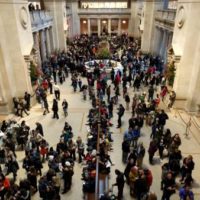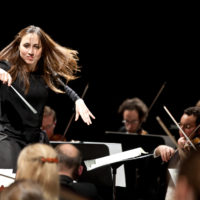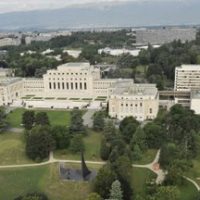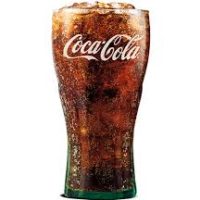I won't link to all the stories on the Metropolitan Museum's new policy of charging out-of-state residents $25 for daily admission - if you're reading this you've seen them already. Here are few additional considerations: A common refrain is that the museum can "afford" to have free admission for all, either through better management of costs, or through increased donations from the very rich. I don't doubt this. But is it a good idea? When a museum chooses free admission it is making a choice on how to use its limited resources. It is … [Read more...]
Women’s wages and employment at the top of the art world
In a new blog post, Anna Bull talks about the paucity of women orchestra conductors, noting only 1.4% of working conductors in the UK are women, and riffing on this statement by award-winning (male) conductor Mariss Jansons: “Hmm, well. Well I don’t want to give offence,” said Jansons, “and I am not against it, that would be very wrong. I understand the world has changed, and there is now no profession that can be confined to this or that gender. It’s a question of what one is used to. I grew up in a different world, and for me seeing a woman … [Read more...]
Soft power and the arts (3/3)
Soft power is the ability for a country to have international influence through means other than the threat of military action or aggressive economic policy (i.e. hard power). How do the arts and cultural diplomacy work as soft power? What ends are being pursued, and how do the arts serve as a means to that end? Researchers through King's College London conducted a study, with extensive interviews of diplomats, at the United Nations Office at Geneva (UNOG). This is a fascinating paper that I will be sure to add to future syllabi in courses … [Read more...]
Soft power and the arts (2/3)
The British Council and the University of Edinburgh have teamed up to prepare an empirical analysis of the actual effects of soft power (my introduction on soft power and the arts is here). How does this work? The idea is to take measures of different assets of a country that we think might contribute to its soft power, and to take measures of outcomes that we think might be influenced by soft power, to see if there's any actual evidence of impact. The report has a lengthy, careful review of what we know and don't know about soft power, the … [Read more...]
Soft power and the arts (1/3)
This week saw the release of two major studies in the UK on culture and soft power: Soft Power Today from the British Council and the University of Edinburgh, and The Art of Soft Power from King's College London. There's a lot of depth to each of the reports, and I'll write about each of them in subsequent posts. I'm relatively new to this aspect of cultural policy, so consider this introduction my own attempt to get a few things sorted out, and some preliminary questions. I began with Joseph Nye's seminal article from 1990. That was a time … [Read more...]
About that Arts Council England economic report
I've been away from the blog for a while, but I just can't keep myself away from economic impact studies of the arts. The latest is from Arts Council England - you can read the report here. Three things: First, the goals of the study are not clear. Britain's Office of National Statistics conducts an annual business survey from which estimates can be derived of Gross Value Added from different sectors, and these figures form the basis of the (2015) arts-sector estimates contained in this report. In other words, we can look up the size of the … [Read more...]
The problem with ranking cities’ cultural vibrancy
Two recent publications derive indices to rank different cities according to their cultural vibrancy - from the National Center for Arts Research in the United States, and the European Commission for European cities. They have the same fundamental problem. In each report, a selection of data series applying to cities' cultural ecosystems is chosen. These are then weighted. The US study makes a ranking of cities according to different measures, then applies weights to how the city ranked - you can see the method on page 7 here: measures of … [Read more...]
Can art corrupt our politics?
At Time magazine, Alex Melamid suggests it can, that the infantilism found in (some) works of modern art has led us, in the end, to an infantile president of the United States: Whatever the intelligentsia nurtures and celebrates in our galleries and academic journals is bound to flow eventually into the nation’s cinemas, through its ballot boxes and toward the swamp of Washington, D.C. The last few months have proven that Trump is not out to drain that swamp. He is its progeny, and we on the left — the artists, the people of culture — have … [Read more...]
Can we, should we, brand “The Arts”?
Barry's Blog has thoughts on this. He points out, correctly I think, that while individual airline companies - Delta, Virgin, Qantas - try to create a brand image of their own, there is also in the public mind an idea of the airline sector as a whole. When one airline treats a customer badly, it does not just reflect on that one airline, but also affects the public perception of airline travel on the whole. And so he asks: What is the Arts Brand - not that of any individual arts organization - but the whole of the arts? I admire his taking … [Read more...]
Cost disease does not explain everything
In my last post I wrote about cost disease, the powerful analysis of economic shifts that results from labor-saving technological change occurring at different speeds in different sectors of the economy. This is an addendum: cost disease explains some changes in costs and prices, but not all of them. It explains why school districts struggle to attract teachers and balance budgets, but it doesn't explain why it costs so much to attend Wellesley. It explains why it's hard for high schools to find bands they can afford to perform at school … [Read more...]










